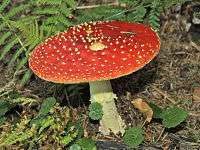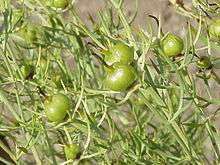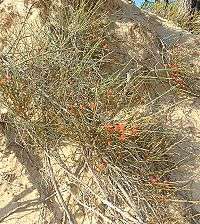Botanical identity of soma–haoma
There has been much speculation as to the original Rigvedic soma plant (and of the Proto-Indo-Iranian *Sauma, which besides soma is reflected in the Iranian haoma).
Since the late 18th century, when Anquetil-Duperron and others made portions of the Avesta available to western scholarship, several scholars have sought a representative botanical equivalent of the haoma as described in the texts and as used in living Zoroastrian practice. Most of the proposals concentrated either on linguistic evidence, or on comparative pharmacology, or on reflected ritual use. Rarely were all three considered together, which usually resulted in such proposals being quickly rejected.
Candidates for the identity of soma
The Rigveda calls the plant soma the "Creator of the Gods"[1] and gives soma precedence above Indra and the other Gods calling soma "a God for Gods".[1]
soma was generally assumed to be entheogenic, based on "RV 8.48". Note, there are numerous similar references in the Vedas, e.g. "RV 9.4"., "RV 9.5"., "RV 9.8"., "RV 9.10"., "RV 9.42". Some descriptions of soma are associated with tapas (heat, excitement, "energy"). Soma is associated with the warrior-god Indra, and appears to have been drunk before battle. For these reasons, there are stimulant (amphetamine-like) plants as well as entheogenic plants among the candidates that have been suggested. Soma is also often associated with Light and Indra is the "Lord of Light" as shown in "RV 8.82.25"..
For thee, O Lord of Light, are shed these Soma-drops, and grass is strewn. Bring Indra to his worshippers. May Indra give thee skill, and lights of heaven, wealth to his votary. And priests who praise him: laud ye him.
Several texts like the Atharva Veda extol the medicinal properties of soma and he is regarded as the king of medicinal herbs (and also of the Brahmana class).
somalata
When the ritual of somayajna is held today in South India, the herb which is used is the somalata (Sarcostemma acidum), a leafless plant that grows in rocky places all over India.
Fly-agaric

From the late 1960s onwards, several studies attempted to establish soma as a psychotropic substance. A number of proposals were made, included an important one in 1968 by Robert Gordon Wasson, an amateur mycologist, who (on Vedic evidence) asserted that soma was an inebriant, and suggested fly-agaric mushroom, Amanita muscaria, as the likely candidate. Wasson and his co-author, Wendy Doniger O'Flaherty, drew parallels between Vedic descriptions and reports of Siberian uses of the fly-agaric in shamanic ritual.[2] Furthermore, the mountainous origin of soma matches the habitat of fly-agaric, and when discussing soma, the Vedas do not mention any part of a flowering tree.[3]
In 1971, Vedic scholar John Brough from Cambridge University rejected Wasson's theory and drew attention to ephedrine (in particular to that extracted from Ephedra sinica), and noted that it "is a powerful stimulant, and would thus be a more plausible preparation for warriors about to go into battle than the fly-agaric, which is a depressant." (for use of parahaoma by soldiers, see reference to the Ab-Zohr in Denkard 8.25.24).[4] This was in turn contradicted in 1974 by Iranologist Ilya Greshevitch, who determined that, in small doses, fly-agaric was indeed a stimulant.[5] In any case, since the "weapon" that Indra uses is the "Vajra" which emits "lightning bolts", the "battles" could not have been physical ones.
J. P. Mallory rejects Wasson's argument that the absence of Vedic descriptions of plant parts point to a fungus, since the Vedas do not describe the plant from which is extracted at all; he explains the references in mountains as a metaphor "recalling soma's lofty origins".[3]
Psilocybe cubensis
Terence McKenna in his book "The Food of Gods" takes issue with the Amanita muscaria theory and suggests the psilocybin-containing Psilocybe cubensis mushroom as a soma candidate. McKenna argues that effects of the A. muscaria mushrooms contradict the description of the properties described in the Rigveda. Mushrooms of A. muscaria have properties that are arguably more deliriant than psychedelic. Psilocybin, the active psychoactive component in P. cubensis, has a strong mind-altering effect. McKenna cites other cultures who use and venerate psychedelic plant-drugs in religious ceremonies such as at Chavin de Huantar, Peru.
Gordon Wasson, who initially suggested that the soma plant was A. muscaria, described Psilocybe cubensis as "easily identified and gathered" in India, and eventually hypothesized, along with McKenna, that P. cubensis was perhaps the true identity of soma. McKenna and Wasson both unsuccessfully attempted to use A. muscaria to achieve a state of consciousness conducive to the development of a religion.
The 9th mandala of the Rigveda suggests that the cow is the embodiment of soma, which provides support for McKenna's theory because P. cubensis is known to grow in cow dung.
A study by Griffiths et al. concluded that psilocybin is capable of producing mystical experiences.[6] These experiences may be conducive to the development of a religious ritual. It is worth noting that the experience of death and rebirth can be brought on by psychedelic drugs, but it is also a central concept of Hinduism (i.e. saṃsāra).[7]
Most promising evidence has been found to be in an ancient rug depicting that of what appears to be kings, priests, and/or even warriors where one is holding this type of mushroom. The rug shows an offering for the haoma ritual next to fire.[8]
Peganum harmala

In 1989, David Flattery, with linguistic support from Martin Schwarz, concentrated again on Iranian haoma. The two again paid particular attention to the hallucinogenic properties that may be interpreted from the texts, and discounted Ephedra because they could not observe Zoroastrian priests becoming intoxicated. They concluded that it was "therefore neither likely that Ephedra was a substitute for *sauma nor that it was *sauma itself" and that the ephedrine and pseudoephedrine alkaloids extracted from Ephedra had to be mixed with the extract from some other plant to achieve the described effects. Flattery proposed the second plant was Peganum harmala (harmal, harmel, Syrian rue, see also harmaline), known in Iranian languages as esfand, sepand or other similar terms related to Avestan word spenta ('sacred', 'holy'). Flattery considered harmel to be the real haoma, with Ephedra only being the secondary ingredient in the parahaoma mixture.[9] Other reasons for preferring Peganum harmala as the identity of soma-haoma is the use of similar chemicals in some South American cultures in a manner reminiscent of the purported role of the drink in Indo-Iranian texts, and its being the only incense plant with hallucinogenic properties in Iran.[3]
Peganum harmala contains harmaline, which is a strong MAO-inhibitor, and it is therefore often used as a first component in ayahuasca ceremonies in order to inhibit the metabolisation of an orally administered DMT molecule (2nd component). Since co-occurrence of DMT-carrying Phalaris grass and Harmala were observed at Yazd, Persepolis, Merv and Termez,[10] the hypothesis stating that soma/haoma was a biochemical Eurasian correlate of ayahuasca cannot be excluded a priori.
Ephedra
Another candidate of the non-hallucinogenic, stimulant hypothesis is a species of the genus Ephedra. Ephedrine, the agent substance in this plant, has a chemical structure similar to amphetamines, and it results in high blood-pressure; according to anecdotal reports, it has a stimulating effect more potent than that of caffeine.
In the late 19th century, the highly conservative Zoroastrians of Yazd province in Iran were found to use Ephedra, which was locally known as hum or homa and which they exported to the Indian Zoroastrians.[11] The plant, as Falk also established, requires a cool (but not cold) and dry climate, i.e. it does not grow in India (which is too hot and/or too humid) but thrives in central Asia. Ephedra distachya is native to southern Europe and northern Asia.[12] Later, it was discovered that a number of Iranian languages and Persian dialects have hom or similar terms as the local name for some variant of Ephedra.
Ephedra plants are shrubs, measuring between 0.2 and 4 meters, with numerous green or yellowish stems. There are about 30 species, mainly Eurasian. The species growing in mountainous regions have the highest ephedrine content (up to 3% in the case of Ephedra equisetina). The marrow in the stems is brown-coloured in some species, reminiscent of Sanskrit babhru ("greyish-brown"), used exclusively in the Vedas to describe the extract.
The different species of Ephedra are not well known, and their taxonomy is in a state of confusion. Assuming a Pontic-Caspian home of Indo-Iranian religions (see Kurgan), the only likely candidate is E. distachya, still used in Iranian folk medicine.
The native name for Ephedra in most Indo-Iranian languages of Central Asia is derived from *sauma- (e.g. Nepali somalata, Pashto Oman/unan, Baluchi hum/huma/uma).
In 1989, in a highly influential text, Harry Falk pointed out that both the Flattery and Wasson arguments assumed that haoma was hallucinogenic, although the effect desired by Zoroastrian and Vedic ritual use was not. Falk noted that, in the texts, both haoma and soma were said to enhance alertness and awareness, did not coincide with the consciousness altering effects of an entheogen, and that "there is nothing shamanistic or visionary either in early Vedic or in Old Iranian texts,"[13](p79) nor could the small doses administered in living Zoroastrian custom justify its consideration as an inebriant. Living custom also does not give the extract enough time to ferment.
Falk established that the effect of the alkaloid ephedrine was, in many respects, similar to adrenaline, but "its actions are less intense but more prolonged than those of adrenaline, and, most important, it prevents sleeping." Chemically, ephedrine is similar to amphetamine (amphetamine itself originating as an innovative "upgrade" of an ephedrine prototypical base). Falk also asserted that the three varieties of ephedra that yield ephedrine (E. gerardiana, E. major procera and E. intermedia) also have the properties attributed to haoma by the texts of the Avesta.[13](p87)
In 1994, Viktor Sarianidi claimed that ancient ritual objects found at BMAC archeological sites in Central Asia bore traces of Ephedra stalks and Papaver (poppy) seeds.[14] In 1995, Harri Nyberg investigated the specimens provided by Sarianidi but could not confirm the claim.[16] Another site provided material which Sarianidi had declared contained traces of Ephedra, Papaver, andCannabis (hemp) in 1998–1999. It was analysed in 2002–2003 by three independent teams, but they found no traces of the claimed contents.[17]
Nonetheless, in the conclusion of his observations on the 1999 haoma-soma workshop in Leiden, Jan E. M. Houben writes that "[d]espite strong attempts to do away with Ephedra by those who are eager to see *sauma as a hallucinogen, its status as a serious candidate for the Rigvedic soma and Avestan haoma still stands."[15] This supports Falk, who in his summary noted that "there is no need to look for a plant other than Ephedra, the one plant used to this day by the Parsis".[13]
Nelumbo nucifera
Based on a detailed botanical analysis of iconography and ancient texts, Nelumbo nucifera, also known as the Sacred Lotus, is another candidate for some. The description of soma in the Vedic texts somewhat resembles the Sacred Lotus. Sacred Lotus is a waterlily that produces golden-red flowers on stalks. These flowers resemble portions of the ancient texts comparing soma to an arrow and the sun. Other Vedic hymns describe soma as having a "ruddy radiance", reflecting the color of the flowers of the Sacred Lotus. Soma is also described in the Vedic hymns as growing "joint by joint, knot by knot", which is a good description of a plant that grows by producing procumbent shoots with nodes and internodes. In addition, benzoisoquinoline alkaloids found in the Sacred Lotus, including aporphine, proaporphine, and nuciferine, are psychoactive, producing feelings of euphoria when ingested.[18][19][20]
Ergot
In The Road to Eleusis, the authors, R. Gordon Wasson, Albert Hofmann, and Carl A. P. Ruck, note the similarity in preparation of the Vedic soma and the Kykeon of the Eleusinian Mysteries. The book hypothesizes that the source of both was ergot (Claviceps purpurea).[21]
Sugarcane
Several authors have identified Saccharum sara, a variety of sugarcane that grows near lakes[22] as source of Vedic soma or with an ancient variety of sugarcane that may presently be extinct.[23][24]
Account by Swami Rama
In his autobiography, Swami Rama recalls contacting an Indian herbologist and Vedic scholar named Vaidya Bhairavdutt, who is described as "the only living authority on soma". Bhairavdutt comes to visit the swami, bringing about a pound of the herb with him. He informs the swami that though the plant's effects can be likened to that of psychedelic mushrooms, it is definitely not a mushroom, but rather a succulent plant.[25](p274) Bhairavdutt convinces the swami to join him in partaking the soma. The taste, says Swami Rama, is "a little bit bitter and sour." Bhairavdutt becomes inebriated and dances wildly, claiming he is Shiva. Several students attempt to restrain the apparently slightly built Bhairavdutt, but are unable to do so. Meanwhile, Swami Rama develops a crippling headache, a symptom which is compatible with the effects of ephedrine overdose. No hallucinogenic effects are described by Swami Rama.[25](pp275–276)
Other, less-popular candidates
- Papaver somniferum
- Argyreia nervosa
- Periploca aphylla[26]
- Sarcostemma brevistigma[26]
- Sarcostemma viminale[27]
- Fermented milk from mare[26]
- Fermented honey[26]
- A mixture of these and other substances[26] (e.g. Peganum Harmala and Phalaris aquatica)
References
- "Rig Veda (Griffith tr.): text - IntraText CT". www.intratext.com.
- Wasson, Robert Gordon (1968). Soma: Divine Mushroom of Immortality. Ethno-Mycological Studies. 1. ISBN 978-0-15-683800-9.
- Mallory, J. P. (1997). "Sacred drink". In Mallory, J. P.; Adams, Douglas Q. (eds.). Encyclopedia of Indo-European Culture. Taylor & Francis. p. 538.
- Brough, John (1971). "Soma and Amanita muscaria". Bulletin of the School of Oriental and African Studies (BSOAS). 34 (2): 331–362. doi:10.1017/S0041977X0012957X. JSTOR 612695.
- Greshevitch, Ilya (1974). Gignoux, Philippe; Tafazzoli, Ahmad (eds.). Mémorial Jean de Menasce. Louvain.
- Griffiths, R.R.; Richards, W.A.; McCann, U.; Jesse, R. (May 2006). "Psilocybin can occasion mystical-type experiences having substantial and sustained personal meaning and spiritual significance" (PDF). HopkinsMedicine.org. Johns Hopkins Medicine. Retrieved 18 December 2015.
- Grof, Stanislav. "The human encounter with death" (PDF).
- "We Drank Soma, We Became Immortal…". SCIENCE First Hand. Retrieved 2020-05-17.
- Flattery, David Stophlet; Schwarz, Martin (1989). Haoma and Harmaline: The Botanical Identity of the Indo-Iranian Sacred Hallucinogen "Soma" and its Legacy in Religion, Language, and Middle Eastern Folklore. University of California Publications Near Eastern Studies. 21. Berkeley: University of California Press. ISBN 978-0-520-09627-1.
- Hromada, Daniel Devatman (2015),The Somahuasca Hypothesis
- J.E.T. Aitchison, "The botany of the Afghan delimitation commission" Trans. LinnEan Soc. of London., 1888.
- MacKenzie, David S. (2002). Perennial Ground Covers. Timber Press. p. 137.
- Falk, Harry (1989). "Soma I and II". Bulletin of the School of Oriental and African Studies (BSOAS). 52/1 (1): 77–90. doi:10.1017/S0041977X00023077. JSTOR 617914.
- Sarianidi, Victor (1994). "New discoveries at ancient Gonur". Ancient Civilizations from Scythia to Siberia. 2 (3): 289–310. doi:10.1163/157005795x00173.
- Houben, Jan E. M. (4 May 2003). "The Soma-Haoma problem". Electronic Journal of Vedic Studies. 9/1a. Archived from the original on 29 July 2010.
- Nyberg, Harri (1995). Erdosy, George (ed.). "The problem of the Aryans and the Soma: the botanical evidence". The Indo-Aryans of Ancient South-Asia: Language, Material Culture and Ethnicity: 382–406. cited by Houben (2003).[15]
- Bakels, Corrie C. (5 May 2003). "Report concerning the contents of a ceramic vessel found in the "white room" of the Gonur Temenos, Merv Oasis, Turkmenistan". Electronic Journal of Vedic Studies. 9/1c. Archived from the original on 13 July 2011. Retrieved 10 February 2011.
- Spess, David L. (2000). Soma: The Divine Hallucinogen. InnerTraditions.
- Spess, David L. (2011). "Errors in Alkaloids of Nelumbo and Nymphaea species". academia.edu.
- McDonald, A. (2004). "A botanical perspective on the identity of soma (Nelumbo nucifera Gaertn.) based on scriptural and iconographic records". Economic Botany. 58: S147–S173. doi:10.1663/0013-0001(2004)58[S147:ABPOTI]2.0.CO;2.
- Hofmann, R.; Wasson, Gordon; Hofmann, Albert; Ruck, Carl A.P. (2008). The Road to Eleusis: Unveiling the Secret of the Mysteries. preface by Huston Smith ; afterword by Albert Hofmann (30th anniversary ed.). Berkeley: North Atlantic Books. p. 91. ISBN 978-1-55643-752-6.
- "The secret of the soma plant". vedanet.com. 13 June 2012.
- Frawley, D. (2012). Soma in Yoga and Ayurveda: The Power of Rejuvenation and Immortality. Lotus Press.
- "Regenerating the soma plant of the Rig Veda". scribd.com.
- Swami Rama (1978). Living with the Himalayan Masters. The Himalayan Institute Press. ISBN 9780893890346.
- McKenna, Terence (1973). Food of the Gods: The Search for the Original Tree of Knowledge. Bantam. ISBN 978-0-553-37130-7.
- Ragozin, Zenaide (1895). The Story of Vedic India as embodied principally in the Rig-Veda. G. P. Putnam's Sons.
Bibliography
- Hofmann, R.; Wasson, Gordon; Hofmann, Albert; Ruck, Carl A.P. (2008). The Road to Eleusis: Unveiling the secret of the mysteries. preface by Huston Smith; afterword by Albert Hofmann (30th anniversary ed.). Berkeley: North Atlantic Books. p. 91. ISBN 978-1-55643-752-6.
- Jay, Mike (1999). Blue Tide: The search for soma. Autonomedia.
- McKenna, Terence (1992). Food of the Gods: The search for the original tree of knowledge. New York: Bantam Books. ISBN 9780553078688.
A radical history of plants, drugs, and human evolution
- Spess, David L. (2000). Soma, the Divine Hallucinogen. InnerTraditions.
- Taillieu, Dieter (2002). "Haoma". Encyclopaedia Iranica. New York: Mazda Pub. Archived from the original on 29 June 2006.
- Taillieu, Dieter (1995). "Old Iranian haoma: A note on its pharmacology". Acta Belgica. 9.
- Vincent, Louis-Claude (1969). Le paradis perdu de Mu. Editions de la source – via Google Books.
- Wasson, Robert Gordon (1968). Soma: Divine mushroom of immortality. Ethno-Mycological Studies. 1. New York. ISBN 0-15-683800-1.
Further reading
- Nyberg, Harri (1995). "The problem of the Aryans and the Soma: The botanical evidence". In Erdosy, George (ed.). The Indo-Aryans of Ancient South Asia: Language, Material Culture, and Ethnicity. Indian Philology and South Asian Studies. 1. Berlin: Walter de Gruyter. ISBN 3-11-014447-6.
- Wilson, Peter Lamborn (2001). Ploughing the Clouds: The Search for Irish Soma. San Francisco: City Lights Publishers. ISBN 0872863263.
